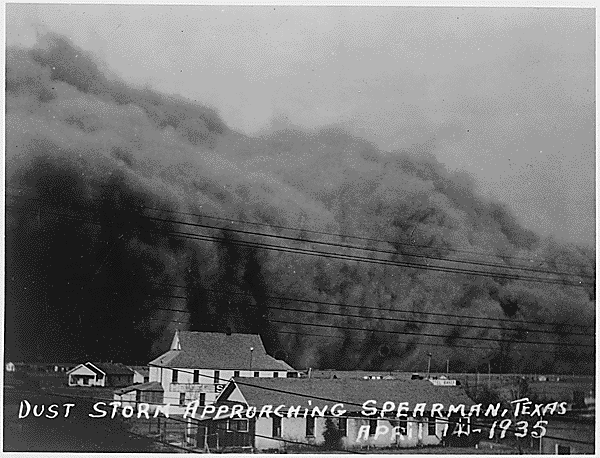The Black Blizzard of 1935
April 14, 1935 dawned as a beautiful spring Sunday across the Plains of Colorado and Kansas southward into Texas.
Residents of the Plains had been beleaguered for four years of dust storms as drought gripped the region. Farmers continued to plow their land, betting that the rains would return. They had settled on the Plains during a rainy cycle in the early 1900s. With plentiful rains and mechanized tractors, they had planted millions of acres of wheat, using techniques that had been successful in New England.
But the summer of 1931 was rainless and hot. The bountiful wheat crops that had set records in previous years suddenly withered to nothing. By 1934, farmers were losing everything.
On this Sunday morning, people were glad to have a day of blue skies. They went to church, hung our laundry and did other chores. By mid-afternoon, residents saw an ominous sight on the northwestern horizon. A low, black cloud sweeping across the Plains approaching quickly.
Many people did not have time to escape the onrushing dust cloud. Many were trapped in their automobiles as they struggled to drive with visibilities reduced to zero in the blinding dust. Daylight was turned to darkness as the black clouds thousands of feet high engulfed entire towns with millions of tons of black topsoil blown from the unprotected land.
There was no escaping the dust. It was everywhere. People hung wet sheets across their windows and doors to prevent the dust from entering their homes. Grit was in food. Thousands contracted pneumonia as they breathed in huge quantities of the choking dust. Many people thought it was the end of the world.
The “black blizzard” of April 14, 1935 was the worst dust storm of the Dust Bowl Era of the 1930s. The great quantities of black dust blew all the way to Washington, D.C., preventing politicians from ignoring the plight of the Plains’ farmers as gritty clouds hung over the Capitol City.
Follow my weather history tweets on Twitter. I am @wxhistorian at Twitter.com.
Category: Met 101/Weather History


















